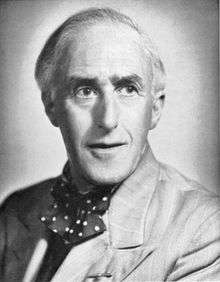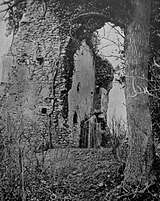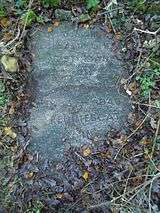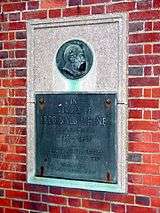Reginald Hine
Reginald Leslie Hine (25 September 1883 – 14 April 1949) FSA, FRHS was a solicitor and historian whose writings centred on the market-town of Hitchin in Hertfordshire and its environs. He committed suicide in 1949 by jumping in front of a train at Hitchin railway station when facing disciplinary proceedings from The Law Society.

Early years
Hine was born in 1883 at Newnham Hall near Baldock in Hertfordshire, the son of Alderman Joseph Neville Hine (1849–1931), a tenant farmer, and his wife Eliza Taylor (1843–1892). Hine was educated at Grove House in Baldock, was privately tutored by the Revd George Todd of Baldock, attended Kent College in Canterbury and The Leys School in Cambridge.[1]
Minsden Chapel

In 1907 he and two others, the Hitchin photographer Thomas William Latchmore (1882–1946)[2] and the noted artist and etcher F. L. Griggs, took a camera to Minsden Chapel with the intention of photographing the ghost of a monk who it was believed had been murdered there and whose spirit was said to emerge from the stone walls of the ruined chapel. Hine claimed that they had been successful and published the resulting photograph in his The History of Hitchin. The photograph is now accepted as having been a practical joke at best, and a hoax at worst, but Hine never admitted this,[3] and its inclusion in what was purported to be a work of serious history is questionable. The shrouded figure is almost certainly that of Hine.
Hine frequently visited here, and eventually obtained a lifetime lease of the building from the vicars of Hitchin. So fond of the chapel was he, that he even bade "trespassers and sacrilegious persons take warning, for I will proceed against them with the utmost rigour of the law, and, after my death and burial, I will endeavour, in all ghostly ways, to protect and haunt its hallowed walls".[4]
Solicitor and historian
Hine studied law and became an articled clerk at 18, working for the long-established firm of Hawkins and Company of Hitchin, but despite his claims to the contrary he did not qualify as a solicitor until he was 50 in 1933. He then went into partnership with local solicitor Reginald Hartley, and for the remaining 16 years of his life Hine practised with the firm of Hartley and Hine[5] until his sudden retirement on 31 March 1949, just two weeks before his death.[1]
In 1910 he delivered a lecture on the history of The Manor of Newnham, where he had been born 27 years earlier. Hine married Florence Lee Pyman (b. 1888/9) on 11 April 1912 in Hampstead and their daughter Felicity was born in 1915. The marriage was not a happy one as Hine's outgoing personality contrasted with that of his colder and more upright wife.[1]
Hine was judged unfit for military service during World War I and he and his family moved to Hitchin in 1917 and to nearby Willian in 1929. In the same year Hine was elected a Fellow of the Society of Antiquaries of London and in 1930 a Fellow of the Royal Historical Society. He was one of the founders of Hitchin Museum which houses many of his own documents.[1] An unenthusiastic solicitor, Hine's first love was the study of the history of his home area. He wrote a number of volumes on the history of Hitchin and its environs, including his The History of Hitchin (1929) and Hitchin Worthies (1932), which won national acclaim.[6] In 1934 he was commissioned to write the History of Stagenhoe.[7]
Historian W. G. Hoskins described Hine's The History of Hitchin as "first class", while Professor G. M. Trevelyan said "I have nothing but admiration for the method, plan and style of it". However, others were not so enthusiastic about Hine's works, questioning his use of sources and historical accuracy, further claiming that Hine would often stretch the facts to make a good story.[7]
Death

Hine committed suicide in 1949 by jumping in front of the slow train from Cambridge at Hitchin railway station.[1][8] In Confessions of an Uncommon Attorney (1946) Hine had written, "Clearly the strain of leading a double life, the accumulation of office worries, and the burden of clients’ woes had worn me down".[5] At the time of his death Hine, who suffered acutely from depression for much of his later years, faced being struck-off as a solicitor for professional misconduct by contacting both sides in a divorce case which was against The Law Society rules, and having bought a return ticket to London he may have been on his way to a meeting there regarding this. He left behind 60 boxes of material for his planned History of Hertfordshire.[6]
He was cremated at Golders Green Crematorium at the same time that his memorial service was being held at St Mary's Church in Hitchin and his ashes scattered at Minsden Chapel on 19 April 1949. His family erected a memorial stone at the site, which was subsequently re-laid in its current grave-like horizontal position after being damaged by vandals in the early 1980s.
His last book, Relics of an Uncommon Attorney, a collection of his later writings, was published posthumously by his friend Richenda Scott,[1] while Hitchin Historical Society have been awarding the Reginald Hine Award since 1979.[7][9] An embroidery he kept in his home is now on display in his memory at St Vincent's church in Newnham, where he was born. Hine Way in Hitchin is named after him, while a small garden with an inset portrait plaque is dedicated to his memory in Lower Tilehouse Street in Hitchin. A biography, The Ghosts of Reginald Hine: An Uncommon Attorney by Richard Whitmore, was published in 2007.
Bibliography


- Anima Celtica (1912)
- Dreams and the Way of Dreams (1913)
- Hitchin Priory (1919)
- The Cream of Curiosity, George Routledge, London (1920)
- The History of Hitchin, George Allen & Unwin (2 volumes) 1927–1929
- Samuel Lucas, His Life and Art Work, Walkers Galleries Ltd (1928)
- A Mirror for the Society of Friends: Being the Story of the Hitchin Quakers (1929 – revised 1930)
- A Short Story of St Mary's, Hitchin, Paternoster & Hales, Hitchin (1930, 4th edition 1946)
- History of Hitchin Grammar School (1931)
- The Official Guide to Hitchin (1932)
- Hitchin Worthies, Allen & Unwin, London (1932)
- The History of Stagenhoe (1934)
- The Natural History of The Hitchin Region (1934)
- The Story of Methodism at Hitchin (1934)
- The Story of the Sun Hotel (1937)
- The Story of Hitchin Town, Wm. Carling & Co, Hitchin (~1938, later reprints)
- Confessions of an Un-Common Attorney (1945)
- Hitchin Old and New: Fifty Photographs and Drawings (1946)
- The Hitchin Countryside: Photographs and Drawings (1946)
- Charles Lamb and His Hertfordshire, J M Dent, London (1949)
- Relics of an Un-Common Attorney, Dent, London (1951)[10]
References
- Alan L. Fleck, ‘Hine, Reginald Leslie (1883–1949)’, Oxford Dictionary of National Biography, Oxford University Press, 2004 accessed 16 Dec 2016
- Thomas William Latchmore on the 'Herts Memories' website
- Whitmore, Richard The Ghosts of Reginald Hine (2007, Mattingley Press (Hitchin) pp. 113–116 ISBN 9780955466205
- Hine, Reginald L. The History of Hitchin, Vol II page 38 (1929, Allen and Unwin (London))
- 'An Uncommon Attorney' – New Law Journal 7 September 2007
- 'History: Reginald Hine and Hitchin' – Hertfordshire Life 12 November 2011
- 'Reginald Hine and Preston' – A History of Preston in Hertfordshire
- Review of The Ghosts of Reginald Hine – Law Society Gazette 6 July 2007
- The Reginald Hine Award – Hitchin Historical Society
- Works of Reginald Leslie Hine (1883–1949) – Hertfordshire Genealogy